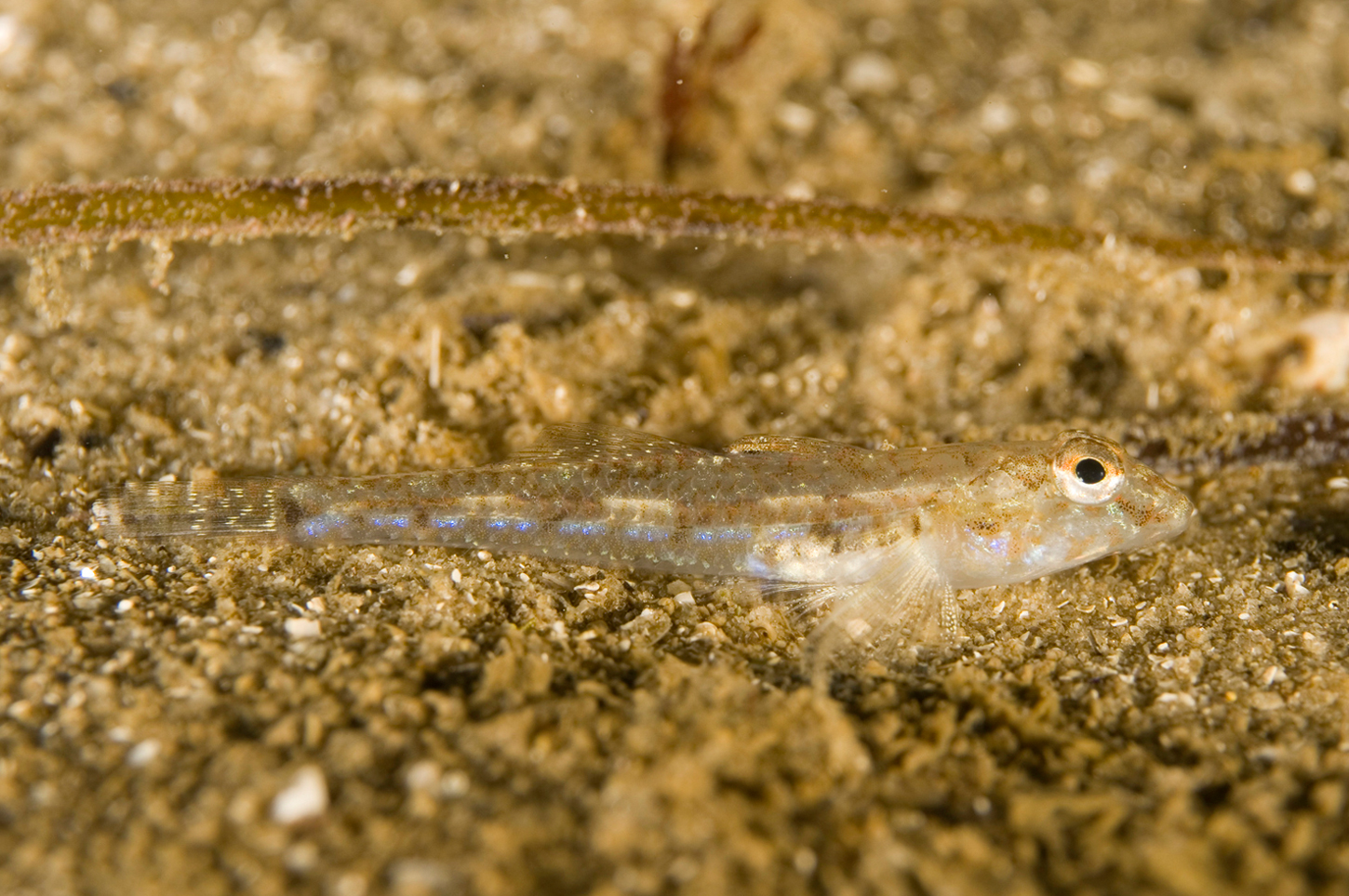- Classification
- ACTINOPTERYGII
- PERCIFORMES
- GOBIIDAE
- Nesogobius
- sp. 5 (of Hoese & Larson, 2008)
Sicklefin Sandgoby, Nesogobius sp. 5 (of Hoese & Larson, 2008)

A Sicklefin Sandgoby, Nesogobius sp. 5, at Port Arlington, Port Phillip, Victoria, July 2020. Source: dentrock / iNaturalist.org. License: CC By Attribution-NonCommercial
Summary:
A translucent to sand-colored goby with a row of blue dashes and widely-spaced tiny, brown or orange spots along the midsides. Males have a dark spot on the base of the rear of the first dorsal fin and a sickle-shaped second dorsal fin. The second dorsal-fin of males appears sickle-shaped, with the anterior rays being much longer that the posterior rays, especially in large fish.
Cite this page as:
Bray, D.J. 2018, Nesogobius sp. 5 (of Hoese & Larson, 2008) in Fishes of Australia, accessed 10 Jul 2025, https://fishesofaustralia.net.au/home/species/5248
Sicklefin Sandgoby, Nesogobius sp. 5 (of Hoese & Larson, 2008)
More Info
|
Distribution |
Endemic to southern Australia and known from Port Phillip, Victoria, to Kangaroo Island and southern Tasmania. Inhabits sandy areas, often in coastal seagrass beds at depths of 2-10 m. |
|
Features |
Dorsal fin VI + 10; Anal fin 10; Caudal fin 13 (segmented rays), 9 (branched rays); Pectoral fin 17-18; Pelvic fin I, 5; Gill rakers: 1-2 + 7-9 = 9-11. Body slender. Head of moderate size (27-29% SL), broader than deep; interorbital narrow, eyes almost touching. Mouth small, oblique, rear end of jaws below front quarter of eyes; tongue tip truncate, or with a shallow notch. Sensory pore beside each nostril, sometimes with one or two median pores between eyes and one pore behind each eye; one pore above rear of each preopercle, no preopercular pores. Gill openings broad, reaching forward to below posterior margin of preopercles; no groove behind each posterior preopercular margin. Head without scales; body scales ctenoid, in 27-33 vertical rows, scales extending forward to a line from just below upper pectoral fin insertions to rear end of first dorsal fin; midline of belly without scales; pectoral fin bases and area before pelvic fins usually without scales. Two dorsal fins; first dorsal fin triangular in shape, originating above pelvic fin insertions, low in females, high in males; anterior rays of second dorsal fin longer than posterior rays, distinctly elevated in large males, resulting in fin having falcate or sickle-shaped appearance, second dorsal fin separated from first dorsal fin by two or three rows; anal fin origin below and just behind second dorsal origin; caudal fin short, with truncate margin. Pectoral fins large, with rounded margin. Pelvic fins fused to form large cup-shaped disc, originating below pectoral fin insertions, reaching to anal fin origin. |
|
Size |
To 5 cm. |
|
Colour |
Translucent with scattered small white spots; thin brown or orange bar from each eye to middle of jaws; thin brown or orange bar from each eye to end of jaws, sometimes obscure; midside with six to eight widely spaced, tiny, brown or orange spots, interrupting white or silver stripe just below midside; rear of caudal peduncle with vertical or oval dark brown spot; first dorsal fin translucent, reddish ventrally in females, having a white stripe with yellowish margin above, often with black between first three spines, males usually with black spot surrounded by white, except ventrally, near rear end of fin; second dorsal fin clear or with faint orange or brown spots forming thin oblique lines; ventral fins clear or white; caudal fin clear or with small red spots forming wavy vertical lines; other fins clear to grey, often with scattered white spots; oval black spot on upper pectoral-fin base. |
|
Feeding |
|
|
Biology |
|
|
Fisheries |
|
|
Conservation |
|
|
Remarks |
|
|
Similar Species |
|
|
Etymology |
|
|
Species Citation |
|
|
Author |
Bray, D.J. 2018 |
|
Resources |
|
Sicklefin Sandgoby, Nesogobius sp. 5 (of Hoese & Larson, 2008)
References
Hoese, D.F. & Larson, H.K. 1994. Family Gobiidae. pp. 781-810 in Gomon, M.F., Glover, C.J.M. & Kuiter, R.H. (eds). The Fishes of Australia's South Coast. Adelaide : State Printer 992 pp.
Hoese, D.F. & Larson, H.K. 2008. Family Gobiidae. pp. 749-773 in Gomon, M.F., Bray, D.J. & Kuiter, R.H. (eds). Fishes of Australia's Southern Coast. Sydney : Reed New Holland 928 pp.
-
Fish Classification
-
Class
ACTINOPTERYGII Ray-finned fishes -
Order
PERCIFORMES Perches and allies -
Family
GOBIIDAE Gobies -
Genus
Nesogobius -
Species
sp. 5 (of Hoese & Larson, 2008)



